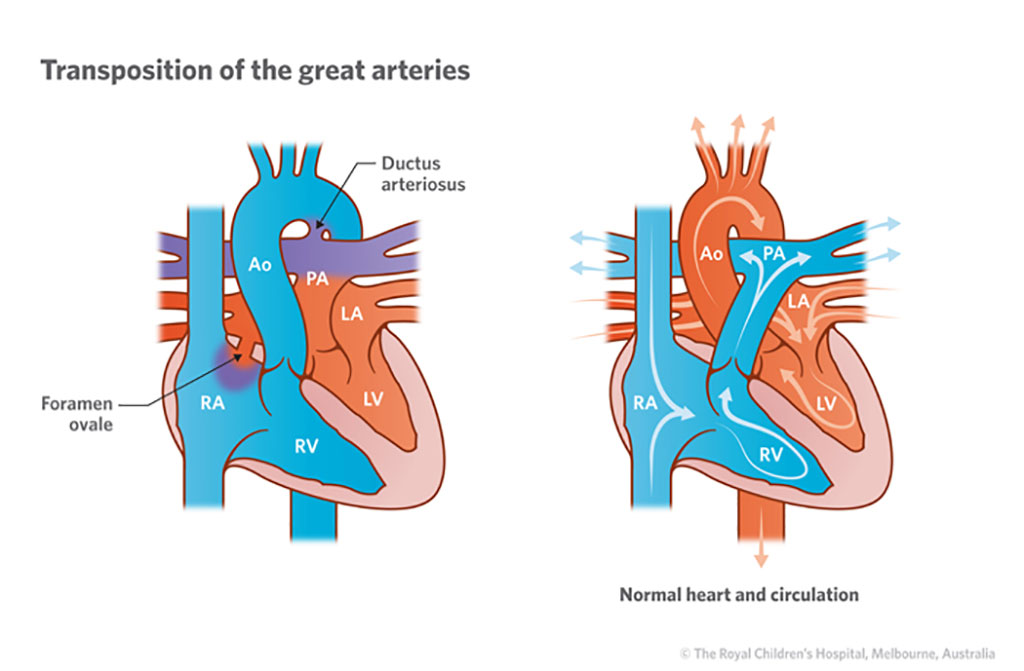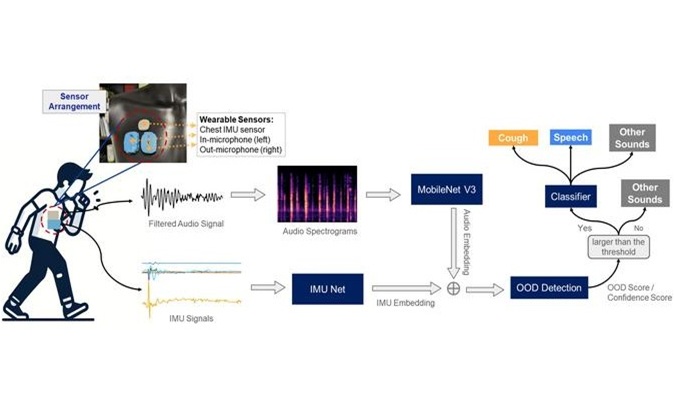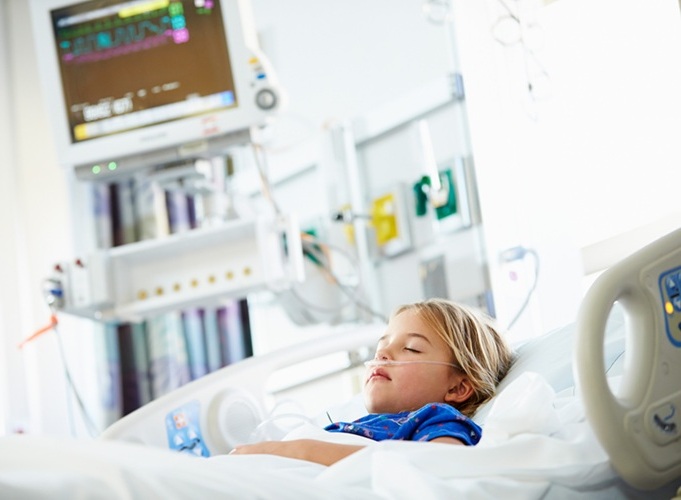Arterial Transposition Correction Reduces Pregnancy Risk
|
By HospiMedica International staff writers Posted on 14 Jan 2021 |

Image: In TGA, the aorta and pulmonary are reversed (Photo courtesy of Royal Children’s Hospital)
Women who had an arterial switch procedure to correct transposition of the great arteries (TGA) tolerated pregnancy well with few complications, according to a new study.
Researchers at Erasmus University Medical Center (Rotterdam, The Netherlands), the German Centre for Cardiovascular Research (DZHK; Berlin, Germany), and other institutions conducted a study involving 41 pregnant women (mean age 26.7 years) who underwent a prior arterial switch procedure for TGA. The primary end point was a major adverse cardiovascular event (MACE), defined as maternal death, supraventricular or ventricular arrhythmias, heart failure, aortic dissection, endocarditis, ischemic coronary events, and thromboembolic events.
The results showed that none of the women died during pregnancy or up to six months after delivery, and only two women (4.9%) suffered a MACE event, with one woman experiencing heart failure and the other developing ventricular tachycardia during the second and third trimesters, which was effectively treated with metoprolol. No deterioration in left or right ventricular function during pregnancy was evidenced. The median gestational age at delivery was 39 weeks and mean birth weight was 2,962 grams. Only one women suffered fetal loss. The study was published on December 22, 2020, in Journal of the American Heart Association.
“During the past 30 years, the arterial switch procedure has replaced the atrial switch procedure to correct TGA. Many cardiologists are reluctant to give green light for pregnancy in these cardiac patients, but our study proves that pregnancy is relatively safe,” said senior author Julien Roos-Hesselink, MD, of Erasmus University Medical Center. “In my opinion, it is also very important to let women lead a normal life, including pregnancy and starting a family.”
TGA arteries is a cyanotic congenital heart defect (CHD) in which the aorta and the pulmonary artery are reversed (transposed), with the aorta arising from the right ventricle and the pulmonary artery from the left. This switch causes deoxygenated blood from the right heart to be pumped immediately through the aorta and circulated throughout the body and the heart itself, bypassing the lungs altogether. At the same time, the left heart continuously pumps oxygenated blood back to the lungs via the pulmonary artery, instead of out into the body's circulation as it normally would.
Related Links:
Erasmus University Medical Center
German Centre for Cardiovascular Research
Researchers at Erasmus University Medical Center (Rotterdam, The Netherlands), the German Centre for Cardiovascular Research (DZHK; Berlin, Germany), and other institutions conducted a study involving 41 pregnant women (mean age 26.7 years) who underwent a prior arterial switch procedure for TGA. The primary end point was a major adverse cardiovascular event (MACE), defined as maternal death, supraventricular or ventricular arrhythmias, heart failure, aortic dissection, endocarditis, ischemic coronary events, and thromboembolic events.
The results showed that none of the women died during pregnancy or up to six months after delivery, and only two women (4.9%) suffered a MACE event, with one woman experiencing heart failure and the other developing ventricular tachycardia during the second and third trimesters, which was effectively treated with metoprolol. No deterioration in left or right ventricular function during pregnancy was evidenced. The median gestational age at delivery was 39 weeks and mean birth weight was 2,962 grams. Only one women suffered fetal loss. The study was published on December 22, 2020, in Journal of the American Heart Association.
“During the past 30 years, the arterial switch procedure has replaced the atrial switch procedure to correct TGA. Many cardiologists are reluctant to give green light for pregnancy in these cardiac patients, but our study proves that pregnancy is relatively safe,” said senior author Julien Roos-Hesselink, MD, of Erasmus University Medical Center. “In my opinion, it is also very important to let women lead a normal life, including pregnancy and starting a family.”
TGA arteries is a cyanotic congenital heart defect (CHD) in which the aorta and the pulmonary artery are reversed (transposed), with the aorta arising from the right ventricle and the pulmonary artery from the left. This switch causes deoxygenated blood from the right heart to be pumped immediately through the aorta and circulated throughout the body and the heart itself, bypassing the lungs altogether. At the same time, the left heart continuously pumps oxygenated blood back to the lungs via the pulmonary artery, instead of out into the body's circulation as it normally would.
Related Links:
Erasmus University Medical Center
German Centre for Cardiovascular Research
Latest Surgical Techniques News
- Novel Glue Prevents Complications After Breast Cancer Surgery
- Breakthrough Brain Implant Enables Safer and More Precise Drug Delivery
- Bioadhesive Sponge Stops Uncontrolled Internal Bleeding During Surgery
- Revolutionary Nano Bone Material to Accelerate Surgery and Healing
- Superior Orthopedic Implants Combat Infections and Quicken Healing After Surgery
- Laser-Based Technique Eliminates Pancreatic Tumors While Protecting Healthy Tissue
- Surgical Treatment of Severe Carotid Artery Stenosis Benefits Blood-Brain Barrier
- Revolutionary Reusable Duodenoscope Introduces 68-Minute Sterilization
- World's First Transcatheter Smart Implant Monitors and Treats Congestion in Heart Failure
- Hybrid Endoscope Marks Breakthrough in Surgical Visualization
- Robot-Assisted Bronchoscope Diagnoses Tiniest and Hardest to Reach Lung Tumors
- Diamond-Titanium Device Paves Way for Smart Implants that Warn of Disease Progression
- 3D Printable Bio-Active Glass Could Serve as Bone Replacement Material
- Spider-Inspired Magnetic Soft Robots to Perform Minimally Invasive GI Tract Procedures
- Micro Imaging Device Paired with Endoscope Spots Cancers at Earlier Stage
- AI Spine Model Could Reduce Surgical Risks
Channels
Critical Care
view channel
Origami Robots to Deliver Medicine Less Invasively and More Effectively
Delivering medicine to ulcers or other internal sites often requires invasive procedures that can disrupt surrounding tissues and lengthen recovery times. Traditional magnetic actuators used in soft robotics... Read more
Improved Cough-Detection Technology Aids Health Monitoring
Coughing serves as an important biomarker for tracking a variety of conditions and can help monitor the progress of respiratory diseases or predict when someone’s asthma is being exacerbated.... Read morePatient Care
view channel
Revolutionary Automatic IV-Line Flushing Device to Enhance Infusion Care
More than 80% of in-hospital patients receive intravenous (IV) therapy. Every dose of IV medicine delivered in a small volume (<250 mL) infusion bag should be followed by subsequent flushing to ensure... Read more
VR Training Tool Combats Contamination of Portable Medical Equipment
Healthcare-associated infections (HAIs) impact one in every 31 patients, cause nearly 100,000 deaths each year, and cost USD 28.4 billion in direct medical expenses. Notably, up to 75% of these infections... Read more
Portable Biosensor Platform to Reduce Hospital-Acquired Infections
Approximately 4 million patients in the European Union acquire healthcare-associated infections (HAIs) or nosocomial infections each year, with around 37,000 deaths directly resulting from these infections,... Read moreFirst-Of-Its-Kind Portable Germicidal Light Technology Disinfects High-Touch Clinical Surfaces in Seconds
Reducing healthcare-acquired infections (HAIs) remains a pressing issue within global healthcare systems. In the United States alone, 1.7 million patients contract HAIs annually, leading to approximately... Read moreHealth IT
view channel
Printable Molecule-Selective Nanoparticles Enable Mass Production of Wearable Biosensors
The future of medicine is likely to focus on the personalization of healthcare—understanding exactly what an individual requires and delivering the appropriate combination of nutrients, metabolites, and... Read moreBusiness
view channel
Philips and Masimo Partner to Advance Patient Monitoring Measurement Technologies
Royal Philips (Amsterdam, Netherlands) and Masimo (Irvine, California, USA) have renewed their multi-year strategic collaboration, combining Philips’ expertise in patient monitoring with Masimo’s noninvasive... Read more
B. Braun Acquires Digital Microsurgery Company True Digital Surgery
The high-end microsurgery market in neurosurgery, spine, and ENT is undergoing a significant transformation. Traditional analog microscopes are giving way to digital exoscopes, which provide improved visualization,... Read more
CMEF 2025 to Promote Holistic and High-Quality Development of Medical and Health Industry
The 92nd China International Medical Equipment Fair (CMEF 2025) Autumn Exhibition is scheduled to be held from September 26 to 29 at the China Import and Export Fair Complex (Canton Fair Complex) in Guangzhou.... Read more













